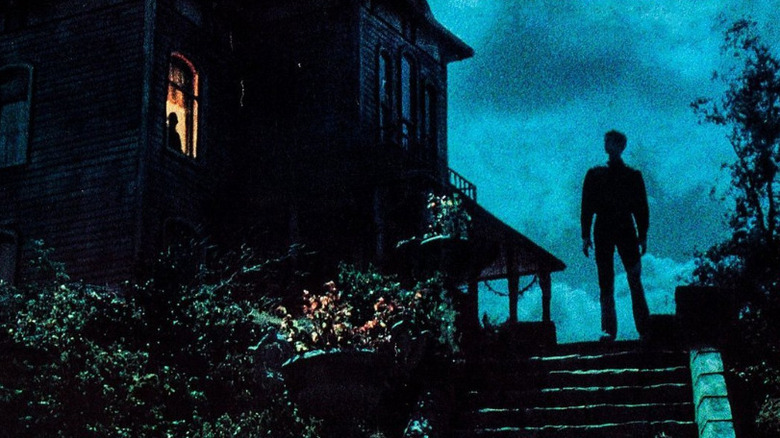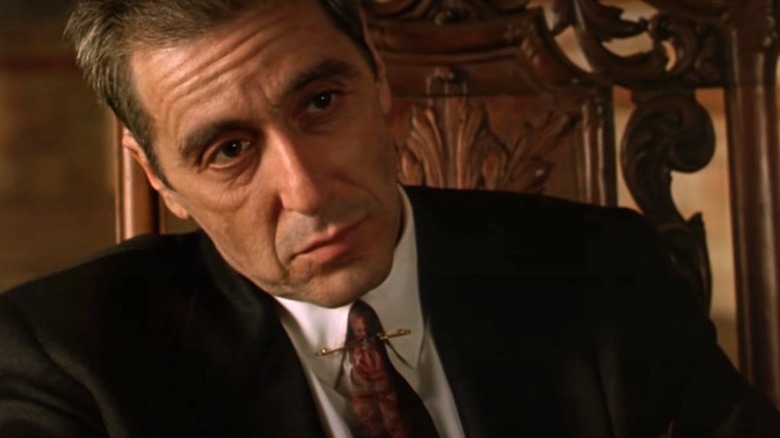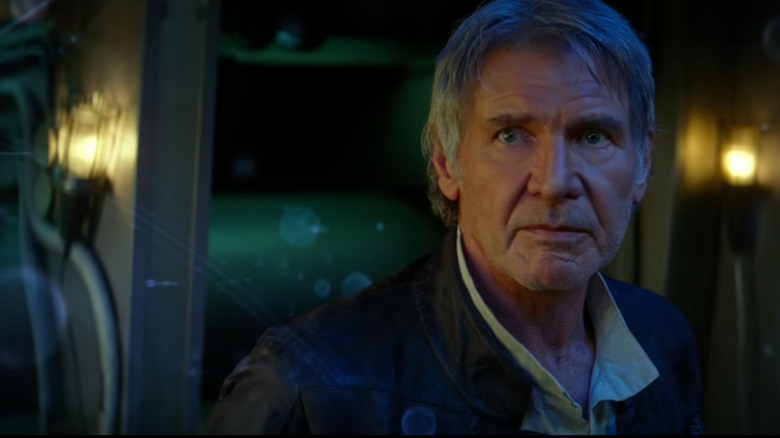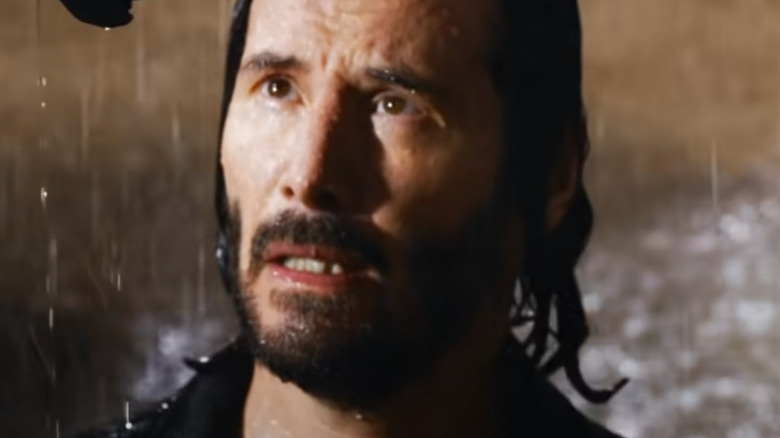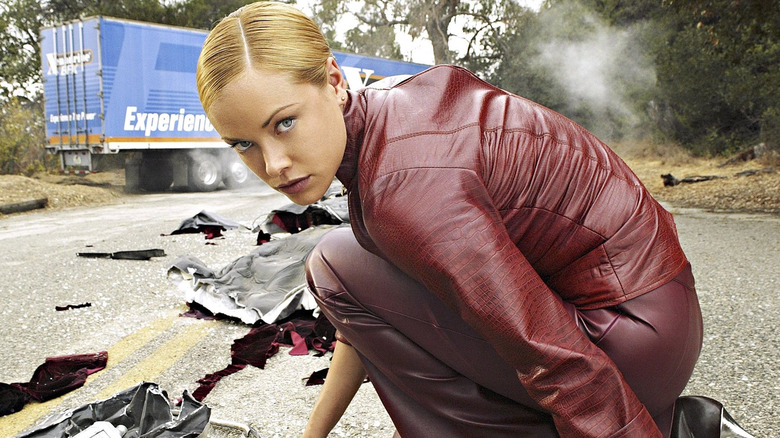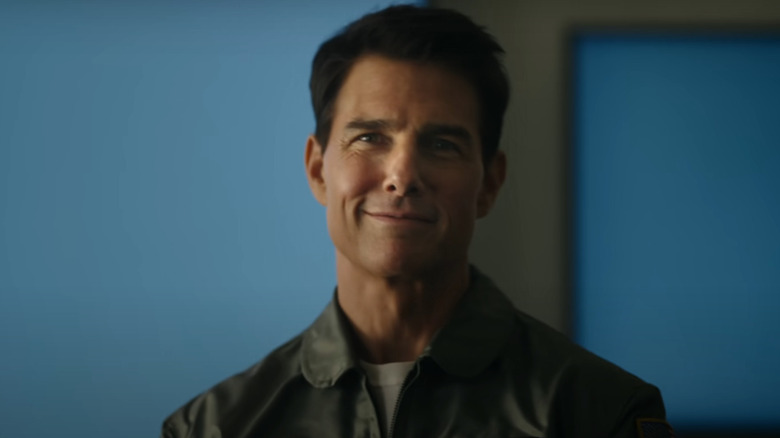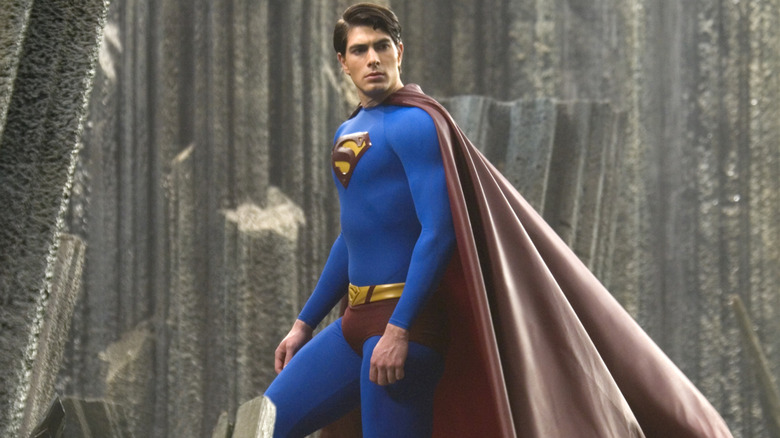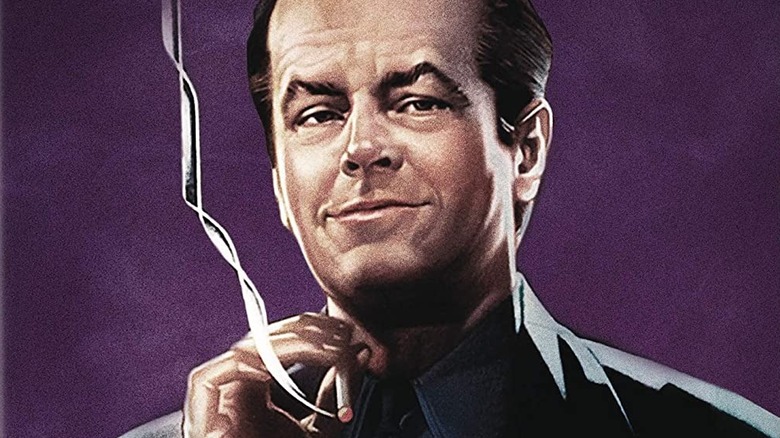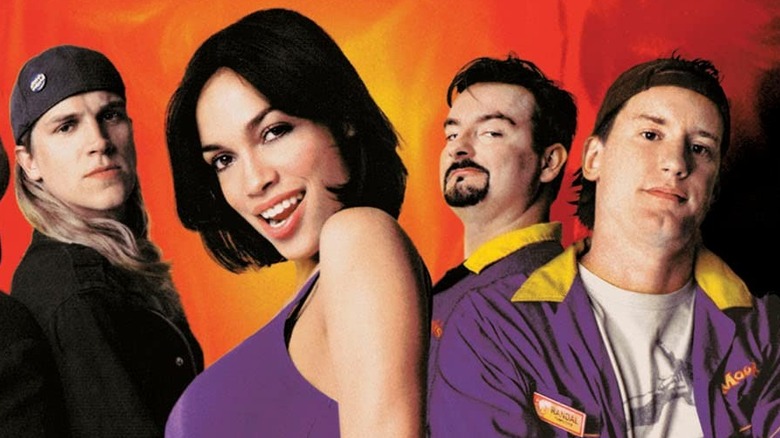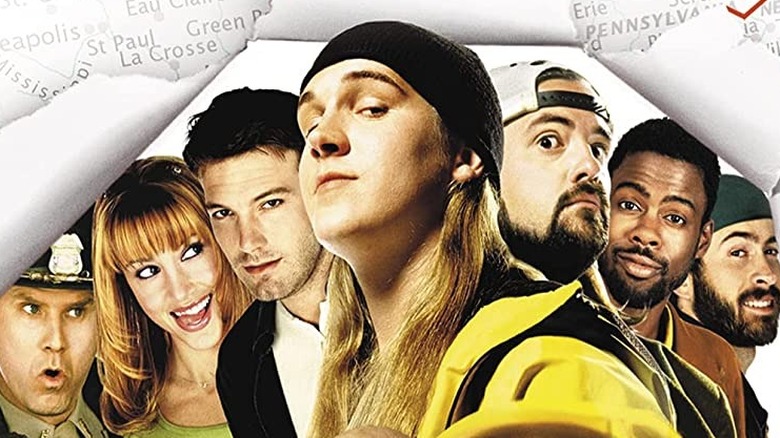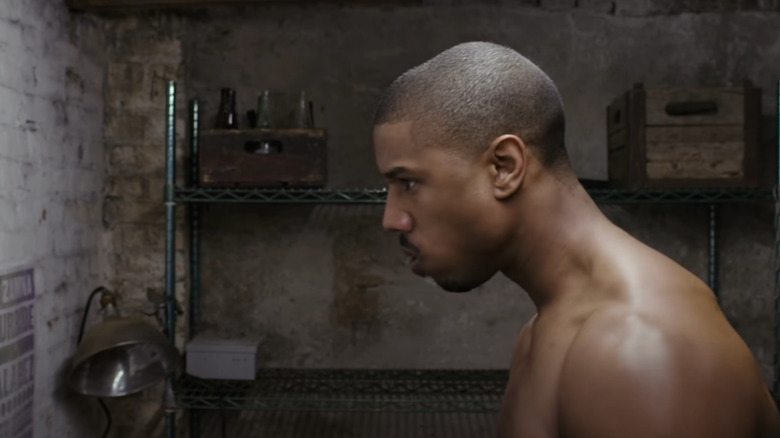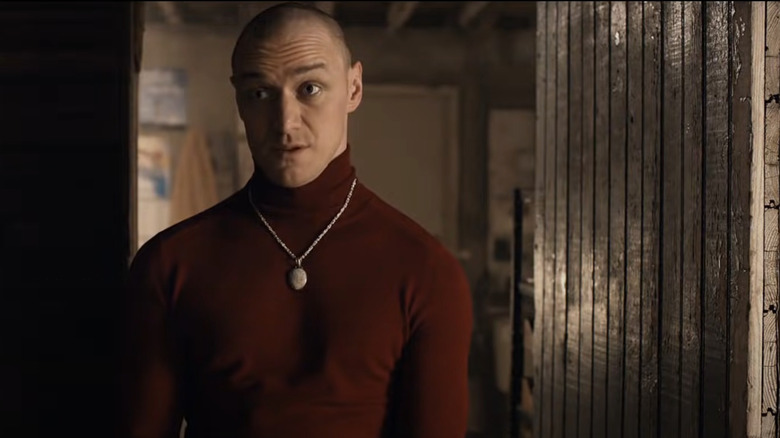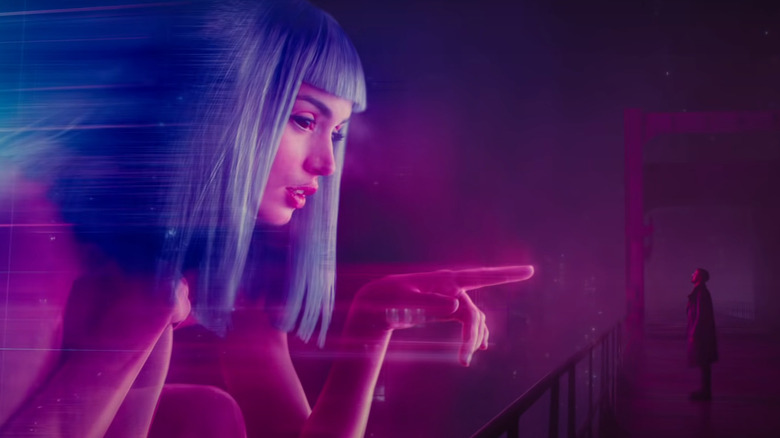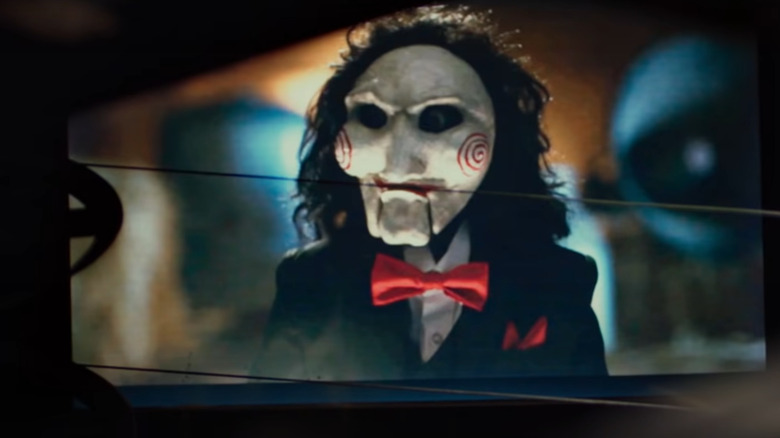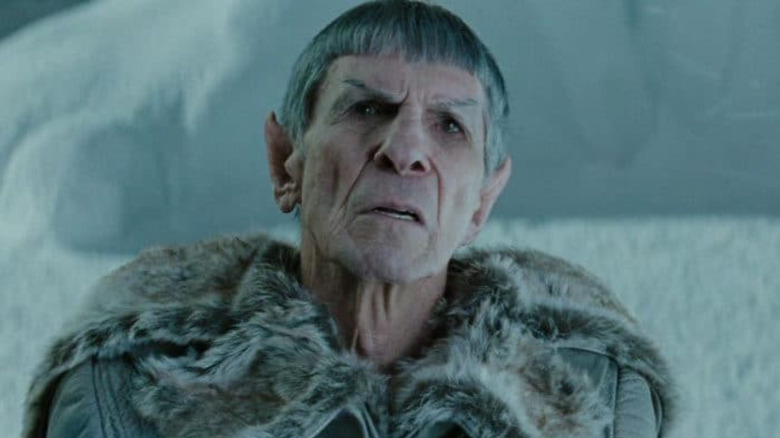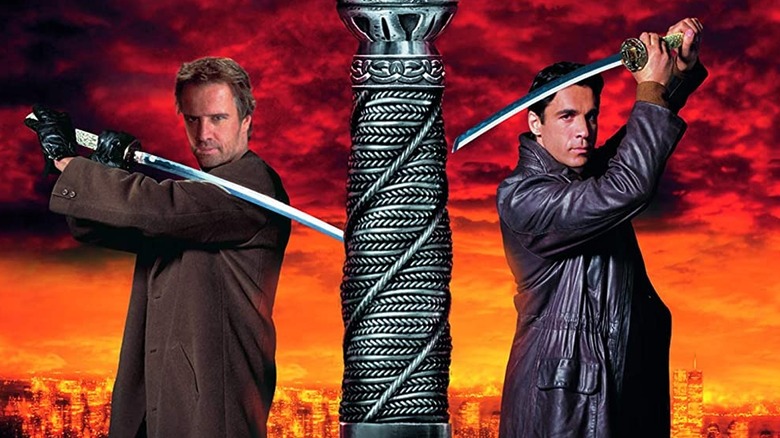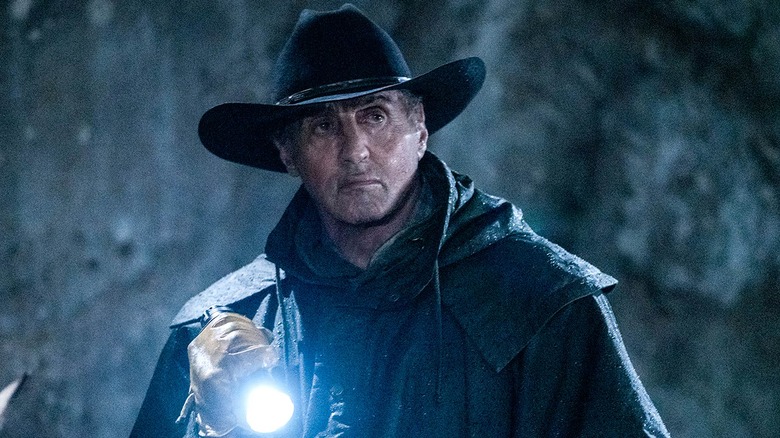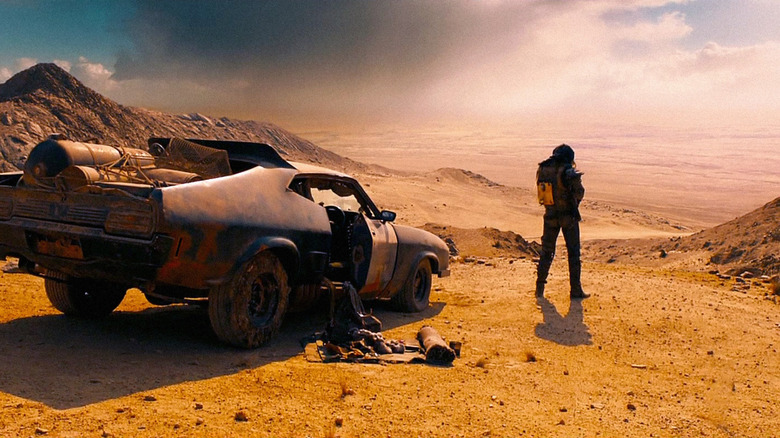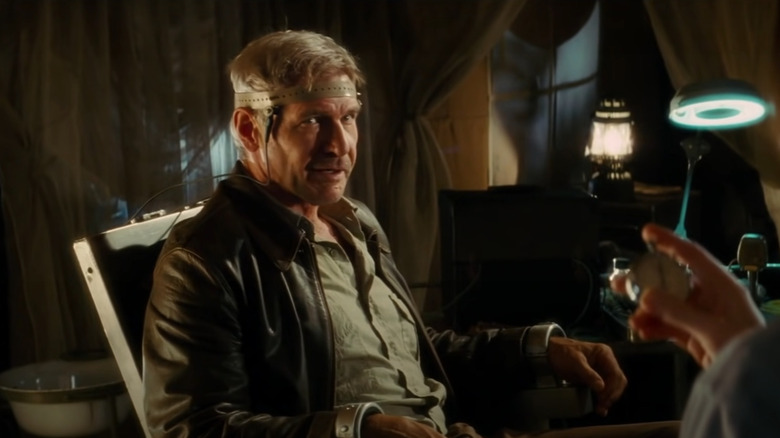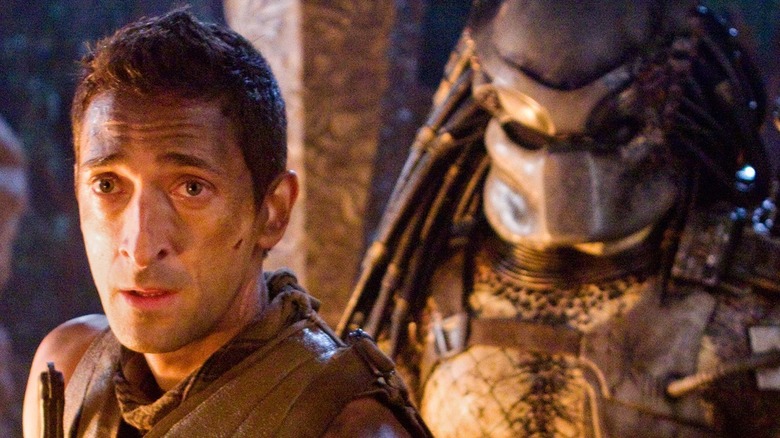The 11 Best And 9 Worst Legacy Sequels
We may receive a commission on purchases made from links.
So, what is a "legacy sequel," exactly? The phrase is used fairly loosely. However, in the most general terms, it's a sequel that arrives after a longer-than-usual time gap. It tends to star at least one returning actor, one or more popular young stars, and a story that allows for a passing-of-the-torch moment. In some cases, it might even overwrite the events of previous sequels, or at least pay so little attention to them that they may as well not exist.
By the time a legacy sequel comes around, the creative forces involved have usually had plenty of time to come up with a worthy follow-up. Not always, though. Here, we've rounded up 11 good legacy sequels, and 9 not-so good ones. It's a list of movies only, so television shows, including the outstanding legacy follow-ups "Cobra Kai," "Chucky," and "Ash vs Evil Dead," do not qualify. Other than that, if you don't see a prominent legacy sequel here, that just means it's an okay, inoffensive entry in the grand canon.
Best: Psycho II
Though it's rarely credited as such, "Psycho II" might be the first true legacy sequel, coming 22 years after Alfred Hitchcock's original film and once again starring Anthony Perkins as Norman Bates. Time works in its favor, as a real-life Bates likely would have been in prison for at least that long. It also helps that the original "Psycho" has a simple story that almost everyone knows, without many extra characters or subplots. In "Psycho II," Norman Bates emerges from incarceration supposedly cured. However, as soon as he arrives home, bodies start piling up again. Either Norman isn't really better, someone else is trying to frame him, or it's a plot to make him go crazy again. Spoiler: It's the last two.
Ignoring the novel of the same name by Robert Bloch, in which Norman dies early on and a different killer assumes his identity, the movie was directed by Alfred Hitchcock fan and friend Richard Franklin, and includes several visual homages to the Master of Suspense. The screenplay kickstarted the career of relative unknown Tom Holland, then best known for "Class of 1984," who would go on to direct "Fright Night" and "Child's Play." The end product was enough of a hit that it spawned two more sequels, making "Psycho" an '80s franchise horror player alongside the likes of "Friday the 13th," "A Nightmare on Elm Street," and "The Texas Chain Saw Massacre." As far as legacy sequels go, that makes "Psycho II" an unqualified success.
Worst: The Godfather Part III
Following up a pair of Oscar-winning classics years later can't be easy. In fact, Francis Ford Coppola proved that it's essentially impossible when he released a third installment in "The Godfather" series 16 years after "The Godfather Part II." Reportedly, Coppola needed the money, and Paramount figured a sequel would make them some. Rather than a true sequel, Coppola considered "The Godfather Part III" more of an epilogue, which was one red flag; Robert Duvall refusing the offered salary to come back was another. Then came the several recastings of Mary Corleone, with Coppola replacing a hospitalized Winona Ryder with his daughter, Sofia, at the last minute. While the role is small enough that anyone who says that her performance ruins the movie sounds hyperbolic, Sofia Coppola has since proven that, when it comes to artistic talent, directing is more her field.
Beyond that, the story relies heavily on knowledge of the first two films, the death of Pope John Paul I, and the subsequent Papal banking scandal. It's barely comprehensible to viewers who are unfamiliar with the characters. Coppola had a chance to recut the film, as he's done with several of his other projects. But, just as Warner Bros discovered with "Justice League," it can be tough to get people to watch a new cut of a movie they didn't enjoy the first time.
Best: Star Wars: The Force Awakens
"The Force Awakens" is the only one of Disney's Star Wars movies that truly counts as a legacy sequel. Everything since is technically a sequel or prequel. Even were it not, though, it's still the film that best balances the nostalgic with the new, bringing back a familiar feeling while introducing several compelling younger characters and fresh mysteries (many of which would, unfortunately, be cast aside or ignored by subsequent installments). One might think that spaceship designs would evolve beyond X-Wings and TIE fighters over the course of 30 years, but at least the stormtroopers have improved, with helmets that look like Apple tech and blasters that actually hit things now.
While several plot beats are familiar, "The Force Awakens" progresses the underlying themes of the Star Wars series. What was once a parable about Nixon and Vietnam is now an examination of the dynamic between narcissistic Baby Boomers with PTSD and their abandoned offspring, as well as the resurgence of fascism. In 2015, this seemed like a metaphor for Putin's Russia; every year since, the First Order seems to parallel domestic concerns more and more.
Next-generation heroes Finn, Rey, and Poe didn't necessarily evolve the way fans wanted them to — frankly, the Finn-Poe shippers were always doomed to be disappointed — but, in the first new Star Wars movie in 10 years, they felt fresh and full of potential. So did the franchise, at least for a little while.
Worst: The Matrix Resurrections
This one is something of a heartbreaker, because there are many interesting ideas at play in the arguably unnecessary fourth "Matrix" movie. The notion that a culture plagued by reboots and reimaginings can only be a dystopian simulation is certainly an amusing concept. Outside of that, the "real" world has cleverly evolved, with humanity finding new mechanical allies and a changed status quo that still contains hostilities, but none that are quite as obvious (or genocidal) as before. Even character resurrections seem plausible within the framework provided.
Unfortunately, that's only half the equation. The original "Matrix" attracted viewers' attention primarily through its ground-breaking action stunts and visual effects. Under the guidance of master Hong Kong fight choreographer Yuen Woo-Ping, "The Matrix" paved the way for Asian action cinema to break into the American market." For "The Matrix Resurrections," however, director Lana Wachowski opted to shoot the action scenes herself. They're a disaster, muddy-looking and barely coherent. When working with her sister, Lilly, Wachowski has never made a movie that wasn't at least eye-catching and worthy of discussion. Too bad that one half of the pair created a movie that's only 50% as good.
Best: Terminator 3: Rise of the Machines
"Terminator: Dark Fate," the sixth Terminator movie, is typically thought of as a legacy sequel. In fact, it's the third attempt in a row to reboot the series. The real legacy sequel was the third film, "Rise of the Machines," which came 12 years on the heels of the hugely popular "T2." Because the second film ended on a hopeful note — though a truly happy ending that would've precluded any sequels was nixed – the third film's return to pessimism and the offscreen death of Linda Hamilton's Sarah Connor didn't sit especially well with fans.
However, like its predecessors, "Terminator 3" reflects the era it was made in. The first "Terminator," which is set in the '80s, tackles the contemporaneous fears of inevitable nuclear war, and its ending reflects that. "Terminator 2," which arrived right as the Cold War ended, contains the optimism of the '90s: Maybe we could change our dark fate and actually achieve world peace. Following the events of 9-11, "Rise of the Machines" reflects a renewed apocalyptic paranoia and the feeling of powerlessness that camealong with it. After the flubs that were "Salvation" and "Genisys," "Dark Fate" tried to return that kind of social commentary to the franchise, but it was unnecessary and too late. For the better, the first three films remain some of the defining sci-fi films of their respective decades.
Worst: Top Gun: Maverick
What happened to Tom Cruise? After a journey that took him from "Top Gun"-era heartthrob to the acclaimed thespian of "Rain Man," a box office environment that failed to reward interesting concept pieces like "Edge of Tomorrow" seems to have driven him to the safety of stunt-driven action movies. His recent films are full of physical risks, but awfully light on acting challenges. The appeal of the "Mission: Impossible" films lies more in the notion that Cruise is endangering his life to make them than any affection for his absurdly perfect superspy, Ethan Hunt.
Cruise's return to the character of Maverick trades on that same appeal. Once you get past the gimmick of Imax cameras inside of real planes, what's left? At an age when most Navy pilots would be retired, Maverick isn't just the best pilot alive. He's also the most noble human being this side of Jesus Christ, testing planes against drones in order to save non-automated human jobs, schooling younger and healthier kids on how to hit targets, and taking the blame for things he didn't do just to protect the reputation of a dead friend's wife. Heaven forbid that Maverick actually pass the torch or acknowledge his years. "Top Gun: Maverick" may be a sequel, but by insisting that the aging Cruise remains at its center, it stretches credulity and gets the "legacy" part all wrong.
Best: Superman Returns
Knowing how large Christopher Reeve's take on Superman looms in pop culture, director Bryan Singer had to perform a tough balancing act while making "Superman Returns." What he attempted was a tall order: a sequel to the two Christopher Reeve movies people liked (one that ignored the two they didn't) that also brought everything closer to the comic books and found new actors for every major character (save Jor-El, who's played by a digitally re-animated Marlon Brando). Though the results were decidedly mixed, it's miraculous that the movie works as well as it does.
Singer and actor Kevin Spacey are problematic figures these days, but their work in "Superman Returns" looked impressive at the time. Spacey channels Gene Hackman's real-estate obsessed Lex Luthor while gradually transforming him into the bald tycoon of the modern comics. Singer took his experience as an adopted child and used it to fuel Superman's emotional conflict — Kal-El is both the beneficiary of adoption and the reason it's necessary for his illegitimate son. Brandon Routh impersonates Reeve better than most could, and callbacks to John Williams' classic score give the whole enterprise a major boost.
Though the movie made money, it clearly wasn't enough; less than a decade later, Warner Bros. opted to reboot the Superman line again, this time with Zack Snyder at the helm. Fans of "Superman Returns" got a happy epilogue, however, in the big CW crossover "Crisis on Infinite Earths." There, Routh returned not just as Superman, but one who was clearly evolving into the iteration from Alex Ross and Mark Waid's popular graphic novel, "Kingdom Come."
Worst: The Two Jakes
A sequel to "Chinatown" had been in the works since 1976, two years after the original debuted. "The Two Jakes" itself was first written in 1984 by Robert Towne. However, it wasn't until 1990, shortly after Jack Nicholson found massive success playing the Joker, that the film finally came out. Even the "Batman" bump couldn't help it. A major reason for the delay was that Towne, producer Robert Evans, and Nicholson were partners on the thing, and Evans insisted that he wanted to act in it, which Towne was against from the moment he saw Evans' screen test. Nicholson ended up directing, albeit from an unfinished script that Towne was still writing during production.
As with "The Godfather Part III," understanding the plot of "The Two Jakes" requires familiarity with its predecessor. Younger viewers who saw Nicholson in the trailers looking like the pre-Joker Jack Napier would have been sorely lacking in their understanding of 14-year-old plot points. Despite respectable reviews, many of which came from critics old enough to know the original film, the inaccessibility to newcomers proved to be killer. Nicholson never directed again.
Best: Clerks II
Twelve years after the breakthrough black-and-white hit "Clerks," Kevin Smith returned to those characters. So did stars Jeff Anderson and Brian O'Halloran, who hadn't had much luck with acting outside of Smith's movies. Smith, known for films about foul-mouthed slackers, tried to take a more mature perspective for the first time in "Jersey Girl," but was derailed by the tabloid romance between lead actor Ben Affleck and Jennifer Lopez, who has a small role in the film. With "Clerks II," the transition felt more natural. Without glamorous leads — save for Rosario Dawson, who has a major part — our reunion with Dante and Randal captured the current state of Gen-X: in flux, trying to become responsible while bogged down with terrible McJobs and a desire to remain edgy.
Kevin Smith has never been great at stepping outside of his comfort zone, but "Clerks II" pushed his limits just enough. In Randal's insistence that he be allowed to reclaim a racist term because he didn't know it was racist, we can see the origins of today's debates over "wokeness" on social media. Rosario Dawson's career, which has taken her from "Kids" to superhero epics, reflects the evolution of pop-culture cinema; in that sense, "Clerks II" serves as a bridge between worlds. Unfortunately, as a way for Smith to transition to stories with more mature themes, it wasn't quite as successful. Not that Smith didn't try, though, at least for a little while.
Worst: Jay and Silent Bob Strike Back
For this entry, we're changing the definition of "legacy sequel" to something more literal. "Jay and Silent Bob Strike Back" wasn't a direct sequel to any one movie. Rather, it was a sequel to writer-director Kevin Smith's entire legacy up to that point. Referencing all of his films, in addition to "Good Will Hunting," "Land of the Lost," "Scooby-Doo," and more, "Jay and Silent Bob Strike Back" was a colossal in-joke meant to close out the "View Askewniverse" and pave the way for more mainstream fare, like "Jersey Girl."
That's not quite what happened. Full of self-congratulatory humor and a conclusion that's nothing more than a petty bit of vicarious revenge against mean internet commentators, "Jay and Silent Bob Strike Back" was the first sign that was Smith in serious danger of disappearing up his own behind. Rage at how Hollywood ruins comic book movies (which was frequently true at the time) is filtered through marijuana and fart jokes, along with repeated references to Smith's other films. It was a cinematic universe finale before people cared about cinematic universes. "Jay and Silent Bob Strike Back" lacks the empathy that, at his best, Smith evinces toward his protagonists, and is mystifying to viewers who haven't seen every prior Smith movie — even for those who have, it's still pretty superficial.
Best: Creed
You could make the case "Rocky Balboa" was the real legacy sequel to "Rocky," but "Creed" is the first film to offer a future for the franchise beyond Sylvester Stallone. Michael B. Jordan stars as the son of the late Apollo Creed, who was killed in the ring by Ivan Drago in "Rocky IV." Stallone's Rocky becomes his trainer, essentially taking on the Burgess Meredith role from the early films. With Stallone now as much of a beloved character actor as Meredith was at the time, and Jordan an up-and-coming big screen action hero, it was a perfect pairing. Add Tessa Thompson as the hearing-impaired love interest, and you've got a stronger lead trio, acting-wise, than maybe any other Rocky movie.
With Adonis Creed coming to terms with the death of his father, there's plenty of built-in drama, especially with Rocky as the guy who could easily be blamed. But "Creed" is also everything a "Rocky" movie needs to be, with a storyline that builds to a big fight and just enough doubt that the hero will prevail to keep audiences tense during the climactic conflict.
Worst: Split
When 2000's "Unbreakable," which was marketed as a supernatural thriller, ultimately revealed itself as a moody real-world superhero origin story, fans naturally wanted to see a sequel. Director M. Night Shyamalan periodically talked about one over the years that followed, too. Still, it's safe to say that nobody was expecting a follow-up quite like "Split," a stealth sequel that only revealed itself as such during its closing moments. Without Samuel L. Jackson and only a single scene featuring Bruce Willis, "Split" mainly focuses on a kidnapper named Kevin (James McAvoy) who has dissociative identity disorder, as well as his latest victim, a teenage girl named Casey (Anya Taylor-Joy).
Mostly, this setup allows McAvoy to play multiple characters at once. That's clearly fun for him, but the story moves from realistic to mildly ridiculous when one of his personalities, dubbed the Beast, turns out to have supernatural abilities. Only after the film's climax did viewers realize this is yet another origin story, that the full-on "Unbreakable" sequel fans wanted for so long was being held off for another movie, and that McAvoy's over-the-top new character was going to play a major role.
This joint follow-up, "Glass," was the real sequel, and in hindsight one of many late-career Bruce Willis movies that was trying to work around the actor's progressive aphasia. Though it wasn't well-reviewed, "Glass" plays out like a low-key riff on "Batman v Superman," and gleefully gives the audience's expectations the middle finger by killing off its hero much too easily.
Best: Blade Runner 2049
The coolest things about the original "Blade Runner" are the production design and the futuristic world it depicts. The least cool thing about it is that, after showing us such a fascinating, large-scale sci-fi world, it proceeds to spend so much time indoors. "Blade Runner 2049," which has the decency not to pretend that the first movie ever took place on our real-world timeline, fixes that by investigating many all-new corners of the future. From a Las Vegas that's been reduced to a wasteland to a high-tech bio-dome, the long-awaited sequel leans into the epic, much as director Denis Villeneuve would later do with "Dune."
It's either brilliant or frustrating — maybe both — that the movie still manages to sidestep the all-important question of whether or not Harrison Ford's Deckard is a replicant. While the original film's director, Ridley Scott, insists that he must be in order for the sequel to exist, Villeneuve preserves the mystery. That's a much stronger choice, especially given how Scott demystified the "Alien" Xenomorph in a truly maddening fashion.
Worst: Jigsaw
When a franchise contains a movie called "The Final Chapter," it's almost never really the end. Older fans often come back for the "finale," which gooses the grosses enough to make the series look viable again. Naturally, another sequel follows, one that's often designed to restart everything. Here's how you do that right: After Jason's "final" outing in the "Friday the 13th" series, he came back as a zombie instead of a really strong deformed guy. After the second "Final Friday," he returned as both an escapee from Hell ("Freddy vs. Jason") and a cyborg ("Jason X").
"Jigsaw," on the other hand, does not do it right. It just offers more of the same. Instead of any changes to the formula, we get yet another retcon involving yet another Jigsaw apprentice who'd never been shown until now. Somehow, the narrative squeezed in more scenes of John Kramer (Tobin Bell) via flashback, too. The farmhouse setting is nifty, but the "twist" that there are two identical games separated by time feels pointlessly convoluted. Besides, if you're going to make an overly complicated "Saw" sequel, you need to bring back previous characters, and to layer the new plot convulsions on top of all the previous ones. Torn between a desire to start anew and to keep Kramer in the story, "Jigsaw" couldn't decide on a fresh course for the series and settled for a generic retread instead.
Best: Star Trek (2009)
"Star Trek" is a unique beast, being both a sequel, a reboot, and a semi-prequel. Perhaps knowing that hardcore Star Trek fans wouldn't stand for a full-on remake, J.J. Abrams recruited Leonard Nimoy to continue the adventures of the original Spock, who travels through time in pursuit of a Romulan criminal named Nero. This spawns an alternate universe known as the Kelvin Timeline, named after the ship that Nero attacks on his arrival in the past. This allows all the familiar "Star Trek" characters to exist, but with different faces and backstories and tweaked personalities.
Considering just how stale the Star Trek movie franchise had become — the prior film, "Nemesis," was literally the third movie in the franchise to be a Captain Ahab riff — Abrams' refresh proved vital. The director gave the proceedings a more epic scope than usual, including some big action setpieces (that skydiving sequence is a real cracker, and gave us the first red-shirt death in ages). Nimoy effectively passes the torch on to the kids, too; Chris Pine became a star playing James Kirk, Zachary Quinto is perfect as Spock, John Cho and Zoe Saldana make Sulu and Uhura even cooler than before, and Simon Pegg, Karl Urban, and Anton Yelchin bring genuine humor to Scotty, Bones, and Chekov, respectively.
Worst: Highlander: Endgame
When the first "Highlander" declared that "there can be only one," it might have made the worst prediction in franchise film history. On the other hand, most moviegoers wouldn't disagree that there is only one ... one "Highlander" film that's any good, that is. The second movie, which revealed that the sword-wielding immortals of the first film were aliens, was an awkward left turn that subsequent entries ignored. The third, which featured a surprise nemesis who'd been buried underground, was so-so at best.
In the meantime, a "Highlander" TV series sprung up, altering the canon significantly. While the show acknowledged Christopher Lambert's Connor MacLeod, it focused on Duncan MacLeod, a distant relative of Connor's who was born decades later into a world where his predecessor hadn't killed all his fellow immortals.
For viewers who didn't watch the show, the fourth "Highlander" movie, "Endgame," was a confusing mess. Bringing Duncan and Connor together in the new TV timeline made no sense, and the film further aggravated old-school fans by having Duncan kill Connor. What should have been a TV movie to begin with became a box office bomb. Its follow up, "Highlander: The Source," which came out seven years later, went directly to the Sci-Fi Channel, and appropriately so.
Best: Rambo: Last Blood
Not everybody likes "Rambo: Last Blood." It's reactionary in its politics, depressing in its outlook, ridiculously violent, and ultimately cynical about human nature. In other words, it's pure Rambo. Introduced in "First Blood" as a killing machine who couldn't turn off once provoked, Sylvester Stallone's anti-hero became a 'roided up symbol of anti-Soviet patriotism over the course of the next two sequels. The fourth film made him a one-man army fighting against a dictatorship, but the fifth, released 11 years later, combined both the original's dark soul and the right-wing patriotism of later entries into a version of the character that's essentially Jason from "Friday the 13th," but with guns.
Ripping away the happy ending of the prior installment, "Last Blood" sees Rambo face off against the kind of Mexican drug cartel that inhabits the darkest MAGA fever dreams. After Rambo takes the fight to the villains' home turf, the bad guys come back across the border, where the traumatized vet prepares brutal deaths for everyone. Rambo's arc has taken him from persecuted victim to ubermensch hero to, finally, slasher movie monster.
Fear the folks who take this movie too seriously, either as a depiction of reality or a piece of political propaganda. In truth, it's neither. Imagine the proverbial two wolves fighting inside Sylvester Stallone. The vicious animal-as-killer is Rambo, while the loyal man's best friend is Rocky. Whichever one he's feeding most at any given time is the one that wins.
Worst: Mad Max: Fury Road
As a movie-length car chase, "Fury Road" isn't bad. It boasts a beautiful color palette, and some impressive stunts behind the wheel. As a character, Charlize Theron's Furiosa strikes a blow against both the patriarchy and ableism. That's generally a good thing.
What "Fury Road" is not, however, is a good "Mad Max" movie. Start with Tom Hardy. An actor who likes to disappear into his roles by making big choices, Hardy's at his best when inhabiting pre-existing characters, like the violent convict known as Bronson or the anti-heroic Venom. Max Rockatansky, however, isn't that sort of character. Max is like Clint Eastwood's Man with No Name: He's a symbol and a blank slate. It's a role that doesn't require someone to disappear into it, but rather a personality to bring it to life. Mel Gibson, for example, got the role by accident because he'd been in a bar fight the night before.
Meanwhile, the villain of "Fury Road," Immortan Joe, is a grotesque abuser with a harem and slaves. He deserves his comeuppance, but when it finally comes, it's over in a split-second. Come on. Max used to fight nigh-unkillable warriors like Wez and Ironbar Bassey. By contrast, Joe isn't much of a threat. Finally, in previous "Mad Max" movies, the car chases served the plot: revenge for a dead family, a lesson in how to serve others, or a way to push beyond idiotic macho posturing. "Fury Road," though, ends right back where it started. Yawn.
Best: Indiana Jones and the Kingdom of the Crystal Skull
The Indiana Jones movies are easy to appreciate on a pure surface level. A guy with a hat and bullwhip fights evil, collects supernatural objects, and escapes tombs full of booby traps. All that stuff is cool. What's even cooler, though, is appreciating the cinematic influences on each installment. See, every Indiana Jones adventure pays homage to a different genre of film from the decade in which it's set. "Raiders of the Lost Ark" is a tribute to the serials of the '30s and '40s. "The Temple of Doom" is infused with the spirit of '30s musicals — not just in the Busby Berkeley-inspired dance sequence that kicks off the action, either, but in its pace, its editing, its aesthetics, and its gleeful embrace of camp.
In the case of "Kingdom of the Crystal Skull," those influences are the sci-fi flicks of the '50s, which are defined by their barely-masked atomic panic. This is what the movie's harshest critics seem to miss. Nuking the fridge, aliens, teens swinging from vines, and giant ants — it's all a tribute to the B-movies of the time. Of course it's not like the other Indiana Jones films. The pulps of the '40s and the sci-fi thrillers of the '50s were drastically different from one another, too.
Nineteen years after "The Last Crusade," George Lucas and Steven Spielberg brought Karen Allen back as Indy's love interest Marion, with Shia LaBeouf as his illegitimate son, unsubtly named Mutt. Commies replace Nazis as the villains, and plenty of preposterous deathtraps await. As usual, it turns out that, if Indy just lets the bad guys have the special thing they're after, they'll end up killing themselves anyway. But that's a franchise tradition, just as like the era-specific trappings — here, aliens and nuclear power — are.
Best: Predators
If you haven't seen "Predators" in a while, you might've forgotten just how awesome the cast is. Danny Trejo rigged up as a human booby trap! Laurence Fishburne and his imaginary friend! Topher Grace as a serial killer! Mahershala Ali before he became famous! And, of course, Adrien Brody, somehow jacked like Schwarzenegger. The first pure "Predator" (i.e., no Xenomorphs involved) adventure in 20 years shook up the formula, tossing some of humanity's deadliest killers onto a planetary game reserve — and into the middle of a Predator civil war.
Produced by Robert Rodriguez and directed by Nimrod Antal, "Predators" introduced a new brand of Berserker Predator (or Yautja, as the species is actually called), kept the "hunting in threes" notion from "Alien vs. Predator," and teased a sequel that, sadly, was never made. More recently, "Prey" proved one-on-one alien-versus-human stories probably play better with audiences, but it was fun to see them duke it out on another planet, if only for one movie.

